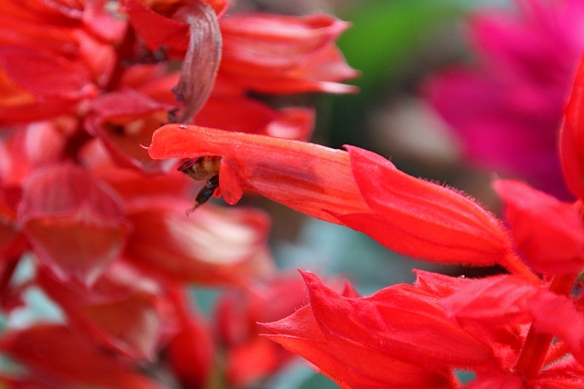I read a blog post where someone tried to hand pollinate milkweed flowers in her yard because there were too few bees, and she was concerned she might not get any seed. Hand pollinating these flowers would be difficult; it helps to have insects do it for you.
The following insects were helping out today in the milkweed patch in the backyard. In any of the photos, look at the most distal portion of the insects’ legs for pale yellow sacs of pollen attached (e.g., left hind leg of the butterfly below).

Red Admiral butterflies

Bald-faced hornets, handsome black and white wasps related to yellow jackets and who can sting multiple times in defense of their large cylindrical papery nests.

An undentified skipper butterfly, with just one or two pollinia attached to its front legs.

A soldier beetle, not really a good pollinator, but there for the nectar reward anyway. Supposedly these beetles eat a lot of aphids, so they are good insects to have around.

Lots of these paper wasps, zooming around the plants, and me. You might think these are yellow jackets, but they have longer bodies, less yellow on the abdomen, and orange antennae instead of black ones.
And this year, for a change, we have honeybees in the garden. There was quite a bit of competition on this particular bunch of flowers, and neither the wasp nor the honeybee would relinquish their position. Actually, I think they were stuck, with their feet caught in the milkweed “traps”, where the pollinia reside.

Milkweed flowers are complex. They have five chambers in which the pollinia are sequestered (black dots in the photo below) that lie in front of five cup-shaped reservoirs of nectar. (photos from http://www.microscopy-uk.org.uk/mag/indexmag.html?http://www.microscopy-uk.org.uk/mag/artfeb05/bjmilkweed.html)

Milkweed pollinia have a central corpusculum from which two translator arms extend and support the paired pollenia sacs.

STEP 1 of the pollination process: In the process of exploring the nectar reservoirs in each flower, an insect might slip its leg down into one of the pollinia chambers and get it stuck on the corpusculum. As it tries to raise the leg to free itself, it drags the entire pollinia assemblage out of the chamber where it remains attached to the insect’s leg while it forages further among the flowers (e.g., the bee in the photo below has several pollinia attached to its right legs).

In STEP 2 of the process, the insect’s leg (with pollinia attached) slips down into the pollenial chamber of a different flower where again it gets stuck, but this time, in raising its leg, one or both of the two pollinia get inserted into the slit that leads to the “egg” or stigmatic chamber.

That may be way more than you want to know about this process, but you can see why hand pollination would be difficult, unless you have really tiny tweezers.
The end result of all of these leg manuevers by the various insects seeking the milkweed’s nectar looks something like this. The flower in the lower center of the photo and the one at about 10 o’clock have several pollinia sticking straight out from the stigmatic chamber, which means that one of the pair of pollinia did get inserted.

Sometimes the insects get their legs so mired in the slits and clefts in these flowers that they are unable to escape and eventually exhaust themselves and die. I am happy to report that both the paper wasp and the honeybee successfully got away from the flower traps.




























